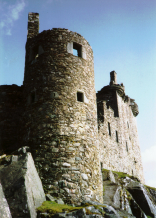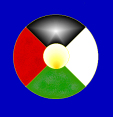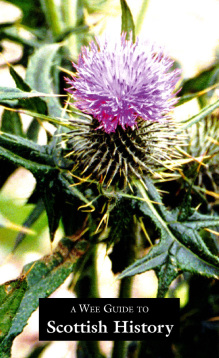The First Peoples
5000 BC First people arrive (Middle Stone Age – Mesolithic)
Not much is known about the first settlers who came to Scotland. Evidence is restricted to tools, weapons and middens. These first incomers were nomads, who lived in caves or rough shelters, and used stone implements. They ate what they could find or catch: deer, eggs, berries, nuts and often shell-fish – some of their middens contain millions of shells. Beyond the coast were forests covering much of the land, so they travelled by boat as journeys by foot would have been slow, difficult and possibly dangerous.
5000-2300 BC First people settle (New Stone Age – Neolithic)
About 4000 BC, settlers began to arrive and farm in Scotland, bringing with them domestic animals, such as cattle, sheep, goats and pigs; and cereal crops, such as wheat and barley. This new way of life involved forest clearance, although these settlers also depended on hunting and fishing. Stone and flint were used for tools and weapons; and they were skilled at making decorated pots, many of which have been found in their tombs.
Their settlements have left little or no trace – apart from in a few caves – except in Orkney, where there are remains of early Neolithic stone houses at Skara Brae and Knap of Howar. These dwellings are built of fine dry-stone masonry and have central hearths. Fittings included dressers, beds and boxes, all carefully fashioned from stone.
These settlers built elaborate chambered tombs, covered by a cairn of stones, to bury their dead. These
cairns take many different forms, some having a single chamber, reached by a passageway, with smaller chambers off; some having a longer chamber, divided by stone slabs into stalls.
The best example of a chambered cairn is at Maes Howe, and there are many other fine examples of both chambered and stalled cairns in Orkney. Practices in burying the dead seem to have varied with place and time: in some the remains were cremated before being buried; in others the body was simply interred; while in others thigh bones or skulls were collected together.
These tombs were used for hundreds of years, previous burials often being moved aside. Pottery and grave goods were also buried with the bodies, and in some of the tombs in Orkney the remains of oxen, dogs or sea-eagles have also been found.
The settlers of this time also erected standing stones and stone circles, such as those at Machrie Moor, and the Stones of Stenness: a henge monument, consisting of a circle surrounded by a ditch. In some cases, these stones were decorated with cup and ring marks, which are also found in many other places throughout Scotland.
2300-500 BC Copper and bronze come into use (Bronze Age)
Trade developed between the settlers in Scotland and the rest of the British Isles and the Continent, and there appears to have been a relatively large and increasing population.
By this time, copper or bronze weapons and implements had begun to be used, although many were still made of wood or bone. Gold was also used for decorative items, such as armlets, cloak pins and dress fasteners. Many artefacts survive from this period as copper, bronze and gold do not corrode as readily as iron.
These people lived in round houses, which now only survive as hut circles, or indentations, in the ground. The walls were either of turf or stone, and a wooden post held up a thatched roof. A central hearth contained a fire for cooking and warmth. Remains of their field systems also survive, as do the heaps of stones which were removed to improve fields for ploughing.
Burials were now in a cist, or stone box, with a stone lid. The body was placed in the grave in a crouched position, usually with a food pot. Cremations replaced inhumations towards the end of the Bronze Age, the burnt bones being deposited in cinerary urns, many of which survive. This pottery is of a characteristic type, hard and thin, red in colour, and decorated with a tooth-like ornamentation. Some have distinguished these settlers as the ‘Beaker People’, suggesting they were incomers from the Continent.
Many stone circles were built, or rebuilt at the same site, including the large circle at the Ring of Brodgar, the stones at Callanish, and some of the circles at Machrie Moor. Other sites were used for burials, cairns being built within the circles, such as at Clava Cairns and Cairnpapple Hill.
1000-400 BC Influx of Celtic peoples & the Iron Age
Around 1000 BC the climate seems to have deteriorated, and become colder and wetter. About this time, the first Celtic peoples arrived in Scotland, people who may have shared a common language and religion. They built hill forts and lived in enclosed settlements, and their societies seem to have been divided into families or clans, led by a chief or king.
There are many hill forts throughout Scotland. Often these consist of a series of ramparts surrounding a hill or cutting off a promontory; or alternatively dry-stone walls, without mortar, were built, some with a timber frame. Some of these enclosures are small, and would hold no more than one family; while others, such as those at Eildon Hill or Traprain Law, could contain a whole town, with workshops as well as houses.
These forts were probably more to protect against a sudden onslaught, rather than a protracted siege, as many have no apparent water supplies. Others are in very poor defensive sites. Crannogs, small defensive settlements on islands in lochs, natural or man-made, were also used during this time.
The inhabitants were farmers as well as warriors, and had domesticated animals, including horses, cattle, pigs, sheep and goats. They also grew cereals, such as barley, and vegetables, such as peas. Iron was smelted and forged into weapons and tools from about 500 BC, wool was spun and woven into cloth, and bone was still used for small items such as needles and combs.
Because iron corrodes readily, there are far fewer iron artefacts dating from this period than copper or bronze items from the Bronze Age.
400 BC-200 AD Duns & Brochs
Hill forts were still built and occupied at this time, but other defensive structures, brochs and duns, were also developed.
Brochs were tall, round dry-stone towers. The walls had a gallery running up inside them, with a stair or storage area. There was only one low entrance, defended by a drawbar and guardroom. The sites were sometimes further strengthened by a series of ramparts, including a blockhouse, in front of the entrance. Like castles, brochs were permanently occupied and do not appear to have been built just for refuge. Many have wells or a water tank built into the floor, and they may have had a timber roof.
The best surviving example is that at Mousa in Shetland, although there are other well-preserved brochs at Dun Carloway, Dun Troddan and Dun Telve at Glenelg, Dun Dornaigil, Clickhimin, Midhowe and Gurness.
Settlements built up around brochs, and were occupied and modified over many centuries. What is not clear is what brochs were built to defend against: rival families and clans, or invaders and pirates, or Roman slave ships.
Duns closely resemble brochs in the type of construction, and were simple stone enclosures, surrounding a defensible rock, or cutting off a headland.
By about 100 BC, these tribes or clans were in two rough groups: the Picts, north of the Forth-Clyde valley; and the Britons to the south and into most of England. Their societies were complex, artistic and probably war-like, no longer purely farmers, with carpenters and masons, metal-workers and merchants, ruled over by a chief or dynasty. They were druids and pagans, although little is known of their beliefs except what was recorded by the Romans.
79-84 AD The coming of the Romans & Battle of Mons Graupius
After successfully invading the south of England from 55 BC under Julius Caesar, the Romans moved north. In 79 AD Julius Agricola, Roman governor of Britain, advanced into Scotland, and built forts at strategic positions. He crushed any opposition, but the Caledonians – as the Romans called them – with a major fortress called Alcluyd at Dumbarton Rock, resisted him. Another invasion by the Romans in 82 AD was followed a year later by the slaughter of the Ninth Roman Legion, probably in Galloway.
At the Battle of Mons Graupius in 84 AD the Caledonians suffered a terrible defeat. Their chief Calgacus, if the chronicler Tacitus is to believed, is the first named ‘Scot’ in history. Calgacus was slain at the battle, along with 10 000 of his men, while only 340 Roman soldiers were killed. Although this defeat was a major setback for the Caledonian tribes, the Romans found it difficult to consolidate their victory.
120-208 AD Hadrian’s Wall & Antonine’s Wall
The northern Caledonian tribes continued to be so troublesome that the Emperor Hadrian had a wall built to keep them from attacking the Roman Province of Britain to the south. Hadrian’s Wall stretched across the country, from Newcastle, on the east side of England, to Bowness, on the southern shore of the Solway Firth. The wall was built of stone, and many forts and outposts were constructed along its length.
The Romans invaded again in 139 AD under Lollius Ubricus. They built another wall, Antonine’s Wall, between the Forth and the Clyde in an attempt to consolidate their hold on southern Scotland. However, they were soon pushed back to Hadrian’s Wall, despite the efforts of the Second, Sixth and 20th Legions to provide the emperor with a victory. In 208, the Romans, this time under Lucius Septimus Severus, attacked again after an uprising by the Caledonian tribes. But his force was harried relentlessly and was soon forced to retreat.
The best surviving section of Antonine’s Wall is at Rough Castle near Falkirk, and parts of Hadrian’s Wall and some of the forts in Northumberland are also open to the public.
296-360 AD Picts & Scots
The Picts were first mentioned by the Romans as the people who held the north and east of Scotland. Little is known of them or of their language – as with all those who came before them – and the lasting remnant of their culture is restricted to carved symbol stones, a collection of which can be found at Meigle, as well as outstanding examples at Aberlemno and Sueno’s Stone in Moray. The Picts were probably a Celtic people, more akin to the Britons and the Gaels than to the Teutonic Saxons.
The Scots, from the north part of Ireland, were first mentioned about 360 AD by the Romans, although they did not use this name themselves. After the withdrawal of the Roman legions from Britain, in 368 the Picts and Scots, along with the Saxons, attacked the south, ravaged the Roman province of Britain, and plundered London of its riches.
Little of Roman culture, learning or influence survived in Scotland.
© Martin Coventry 2018









